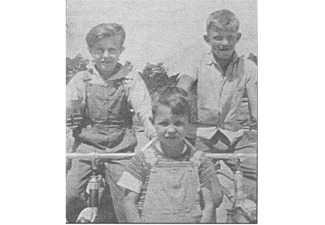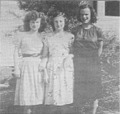

Julian's Memoirs

L to R: Gene Dawson, Howard Ray and Julian Thomas

L to R: Linda Yeomans Joseph, Imogene Dutton Dasher and Joan Bland Tatum

Julian at Shellman Bluff, his first trip. He was among a group of 8th or 9th grade students who were taken by Mr. J.N. Wall to the coast.
The Good Old Days
by Julian Thomas
The following is reprinted from The Glennville Sentinel, Glennville, GA, Senior Moments Edition, March 10, 2005. The pictures at left along with their captions are taken from the same article. Special Thanks to the Glennville Sentinel for researching and publishing this bit of our family history.
I was born on May 2, 1934, to parents Bertha Mae Barrow Thomas and Rufus B. Thomas in the middle of the great depression.
Over the next 20 years, our family would grow to some seven active boys and girls. Twin females born prematurely before me did not survive. I was the only bird in the nest for five years.
Prior to starting school, I stayed with my grandparents from time to time. We made one move during this time. I remember my father placing my little red wagon in an area between the fender and the hood of his old truck. I feared the loss of my little red wagon but we made it to the new home.
This new home was the result of help from Mr. Bert Rahn (grandfather of Judge Ronnie Rahn). It had been Mr. Rahn’s property. Mr. Bert was a director of a local bank and helped Daddy finance the sale.
I grew up as did most all Depression-era children, fortunate to have parents who looked after their family. It was Christmas only one time each year—Roy Rogers and Gene Autry pistols and fruit (apples and oranges), Cracker jack popcorn, and fire crackers.
There were heads of families who could not cope with the Depression years. Some husbands, I have observed and read about, were alcoholics and squandered what money they had to drown their misery.
Sharecroppers
Sharecroppers were farmers who usually did not own any property. Landowners would agree with sharecroppers to furnish land, house and different ways of sharing fertilizer cost. The sharecropper would furnish the labor and when cotton was king, large numbers of children were an asset on most farms.
There were some unscrupulous landowners. While they were dealing with the sharecropper, they provided a run bill (credit) to purchase basic needs of food and bolts of cloth during the year. Then when settling time came after harvest, the landowner would tally the run bill to come out about even.
Such a story is told in Glennville of these types of things happening. The landowner stated to the sharecropper that he had a good year. He broke even. The sharecropper asked the landowner about a bale of cotton in the back corner that had not been figured in when he was tallying the year’s work. It wasn’t figured, the sharecropper asked. No sir, it wasn’t the landowner replied. You should have told me. Now all that figuring will have to be done again.
Most sharecroppers were good Christians, to the extent in my opinion that they neglected to stand up to the landowners for themselves and their families. They thought if they went to church at the set time, everything would be all right.
Children took care of many chores on the farm: feeding the mules; drawing water (no REA electricity); feeding, watering, and milking cows; and keeping the milk clean.
Mother would keep milk overnight in a container and the next morning would skim the cream and collect the small amount to make butter. We never owned a butter churn. She used a half-gallon fruit jar filled about half full and kept it in motion until the cream and milk separated. (Footnote: to get the most cream, you separated the mother cow from the calf and milk the mother until there was little flow. Then allow the calf to nurse the mother for a few seconds. Separate them again and milk the mother again. Nature somehow gives the mother cow the ability to hold back the most butter-filled milk until the calf could butt the udder and cause the high-butter content to be released.)
Citizens of this area and others tended to remain in their respective areas. Prior to World War II, courting was limited due to time and distance. Consequently, there were a limited numbers of marriages outside of one’s home area. Look at a telephone book prior to World War II and note the few dominant surnames locally. Look at today’s telephone book. There are now many surnames locally I can’t pronounce! Two major factors that appear to be a cause of this were the influx of young males for military training to Fort Stewart at the beginning of World War II, and the economic improvement from war-time spending that made it possible for more students to enroll in college and move away from their local area. While away from home, they were meeting people in collage who were in the same situation. Many married and returned home, while others went to their spouses’ home area.
Employment Other Than Sharecropping
The Turpentine industry provided the raw material for Naval Stores which were used for sealing cracks in ships. The raw material provided by the Turpintine industry was the crude gum or tar from pine trees which was collected in the following way: once a week during the hot weather, a fresh new cut or streak was made on the face of a pine tree opening the pores and causing tar to run out and collect in a cup. This procedure produced a full cup in three to four weeks, depending on the soil, the moisture, and the size of the pine tree. About 300 cups could fill a barrel. “Dipping Tar” was hot, heavy, hard work, and the collection process was complicated by obstacles in the path from one tree to the next such as bushs, briars, and limbs from other trees. As the collector made his way from one tree to the next collecting tar, he made a half circle, working away from the collection barrel and then curving back to the barrel with (hopefully) a bucket full of tar to add to the barrel.
Most two-horse farms had turpentine trees around the wooded and wet areas. This could be anywhere from a three to twenty barrel stand of turpentine pines which were worked by family members or by fifty-fifty arrangement with outside help.
My father was engaged in providing freight and barrels for getting the tar to market. This was a good cash crop supplement to the farm.
With the development of cleaner, cheaper synthetic materials, the demand for rosin and turpentine went away and the turpentine business died. The pine trees that had previously provided the now unneeded tar were cut and processed.
Shad fish were caught from the mouth of the Ohoopee River in the Altamaha for sport and to supplement income. During winter months when shad would migrate upstream to spawn, female shad were most desirable for their roe and their meat and was not as boney as the males.
There was another source of income for some of the more adventurous men of the community—moonshine whiskey. It's commonly accepted that the name “moonshine” arose from the necessity to work at night because of the smoke produced by the wood fire used to heat the evaporator pot (which caused the alcohol to separate and recondense). During daylight hours, the presence of an otherwise unexplained raising trail of smoke would serve to very effectively pinpoint the still. The availability of L.P. gas eliminated the rising smoke problem and allowed Moonshiners to operate whenever they chose.
Another giveaway was the purchase of large quantities of sugar necessary to produce good whisky. I’m told that federal and state agents would check sales of sugar.
After the repeal of Prohibition and the return of commercial distillers, good, safe, legal whiskey was available at a price that was competative with the moonshiners even after the tax added. The end of Prohibition pretty much eliminated the production of illegal whiskey in this area.
Hog Killing
In those days, Neighbor Helping Neighbor was a way of life. Pork was a major food supply and one of the events that depended on neighborly help was Hog Killing. Hogs would usually be given full feed for several weeks in the fall and early winter. Neighbors would alert each other as the time approached. Since the only refrigeration was blocks of ice delivered or picked up at the ice plant, weather was a major consideration. Cold (preferably near freezing) and windy was the proper time to kill hogs.
The entire family, to include the youngsters, took part. A cast iron boiler was filled with water and a fire started under it. When the water started to steam, the farmer or one of the neighbors would move a finger hurriedly through the water to test it. This might be done several times before he pronounce it to be ready. The hogs, usually five to ten, were slaughtered one by one, taken to the boiler and submerged in the boiling water. After the hog was removed, the bristles were pulled from the skin, and the hog was put on a cross arm for the gutting process.
Organs were removed and intestines were taken to be cleaned and used for sausage casings. Liver, the head (for hog head cheese) and feet were all used. Fat was trimmed and rendered for cooking oil. With the cold weather keeping the meat in good condition, the hogs were butchered into desired pieces. Some would be carried to the ice house for curing and safe storage.
Jimmy McCurdy’s father, Mr. Mac McCurdy, was owner and operator of the ice plant and also operated a fleet of ice-delivering trucks in this area similar to rolling stores.
Peanut Boiling
In late summer when peanuts were maturing, youngsters would gather and pick off peanuts to be boiled that night in a cast iron wash pot or similar cooker. Youngsters would gather, shell and eat around the pot and play.
Half Right, Half Wrong
This was a game we often played during a Peanut Boil. One couple would go down the road away from the pot and secretly select two other youngsters from the group to make a couple. Two others from the group would form another couple and walk down the road to the first couple, who would tell them if they had guessed correctly or not. “Half right, half wrong” meant that one of the couple had been selected and one had not. “All wrong” meant neither youngster in the couple was selected. By changing partners in the second couple, the game continued until the couple was told they were “All right.” This couple would then replace the first couple and make their own secret selection.
Cane Grinding
Most every farm had a cane patch. There were three main varieties. POJ (I was told it meant “Pride of Jamaica”) was noted for its sweet juice. Cane matured in late summer or fall, and it was necessary to keep frost from freezing the cane tops. If for some reason the cane was kept in the field, every effort was made to strip the blades (leaves), cut the top out then stake and cover the cane with the blades.
At our home, cane syrup was a major staple for breakfast and a major incentive for processing sugar cane into syrup. The process was tiring work. Once harvested, the cane stalks had to be manually loaded onto the mule drawn wagon for transport to the cane mill. The mule-powered cane mill was either a two or three-roller type. The mule was attached to a “sweep” by way of harness. The sweep was a tree about six to eight inches in diameter on the small end which was about ten to twelve feet distant from the mill frame. The mule would walk around in a circle while some unlucky teenager got to feed cane into the mill rollers. As night began to close in, the call came to get one more cooking (of cane juice) before closing down. (Water was evaporated from the cane juice in an oval-shaped open top boiler over a wood-burning furnace.)
Almost full, the unlucky teenager would think just as a group of neighbors stopped by with a jug to be filled. The teenager’s Daddy would say, "of course, help yourself" and that meant another half hour before stopping and then seeing about that old mule before he could call it quits and join the other teenagers.
Sugar was rationed during World War II, which led to the development of saccharin. Sweet and Low came later.
During World War II, soldiers were active in practicing military tactics on private land in areas around Glennville. Some were training with huge search lights to spot airplanes during the night.
Occasionally during the day, a blimp would drift by. Once, over the school yard at Tyson, the blimp occupants released a roll of toilet tissue and held onto one end as they drifted by.
The story goes that one day in an area not too far from the school, another blimp was drifting over a farm where father and son were working in the field. The father spotted the low drifting blimp and called to his son to catch the old mule, there comes a submarine.
Growing up with neighborhood friends was a wonderful experience. The nearest and best was Gene Dawson. Gene and I were together every free moment we had from chores. We would fish or hunt according to what the season allowed. Each of us was part of whichever home we happened to be in. His mother, Mrs. Katherine Dawson, made me feel very welcome at meal times. We shared many fine meals in Mrs. Katherine’s kitchen. Gene and I remained close until high school. When I became involved in sports, he and I drifted apart and later my family moved to another community. I visited Gene just recently and we reminisced about the good old days.
While there were several boys in our community, another special friend was Leroy Purcell. One thing I fondly remember was Leroy sharing his new bicycle so that me and others could learn to ride. Most all the roads in our area were sandy except for a stretch near his home. This road was good for bicycling. He allowed us to take turns on his new bicycle. My thanks to you again, Leroy for that, and for being my friend.
Church and Sunday School
My family attended Oak Grove Baptist Church. My earliest remembrance of attending church was that the services were held monthly on Saturday and Sunday. We had revival services every year in August or September. When I was about thirteen, I received Christ during the revival being conducted by Reverend James Bacon. I remained a member of Oak Grove for several years, being involved in Sunday School with the intermediate class. I later moved my membership closer to home to First Baptist Church of Glennville.
During my teenage years, I attended Sunday School taught by Irvin Percell who would drive his father’s school bus to church to serve as our classroom. During the summer months, we would go to the Ohoopee River where he would teach us how to swim. Sometimes, when Miss Miriam, his future bride, was visiting from Florida she would assist in teaching.
During 1951, my senior year and the last year of 11th grade graduates (thereafter 12 grades were required for graduation) I met a girl, Jackie Deloach, who would become my wife in 1952. We each played basketball which allowed us to become better acquainted.
There were 73 members of the Class of 1951 and we were the only classmates to marry another class member.
On a particular basketball road trip to Metter, the girls played first as usual, which gave them a chance to shower and change during the boys game. This scheduling arrangement also allowed the girls to board the bus first. Jackie sat on the outside of her seat, not allowing anyone to sit with her, claiming to be saving the seat for me. I think she was really keeping the entire seat to herself to rest during our drive home. When I boarded the bus, the other players insisted she allow me to sit with her. She did and in 2004 we celebrated our fifty-second anniversary.
On November 15, 1952, I made arrangements with Mr. W.H. Bazemore, Probate Judge at the Reidsville Courthouse to be at his office on Saturday afternoon to marry us, which he did. Jackie and I went to Sears & Roebuck in Savannah where we purchased enough pots and pans to cook a meal. We honeymooned in Savannah Georgia.
On October 3, 1953, Danny Thomas was born. He only increased our family by one but he multiplied our joy many times. He gave us happiness in so many ways. When he was 31, we tragicly lost him in an accident. But, he left us two grandsons, Brett and Drew Thomas, who continue to give us joy and happiness.
